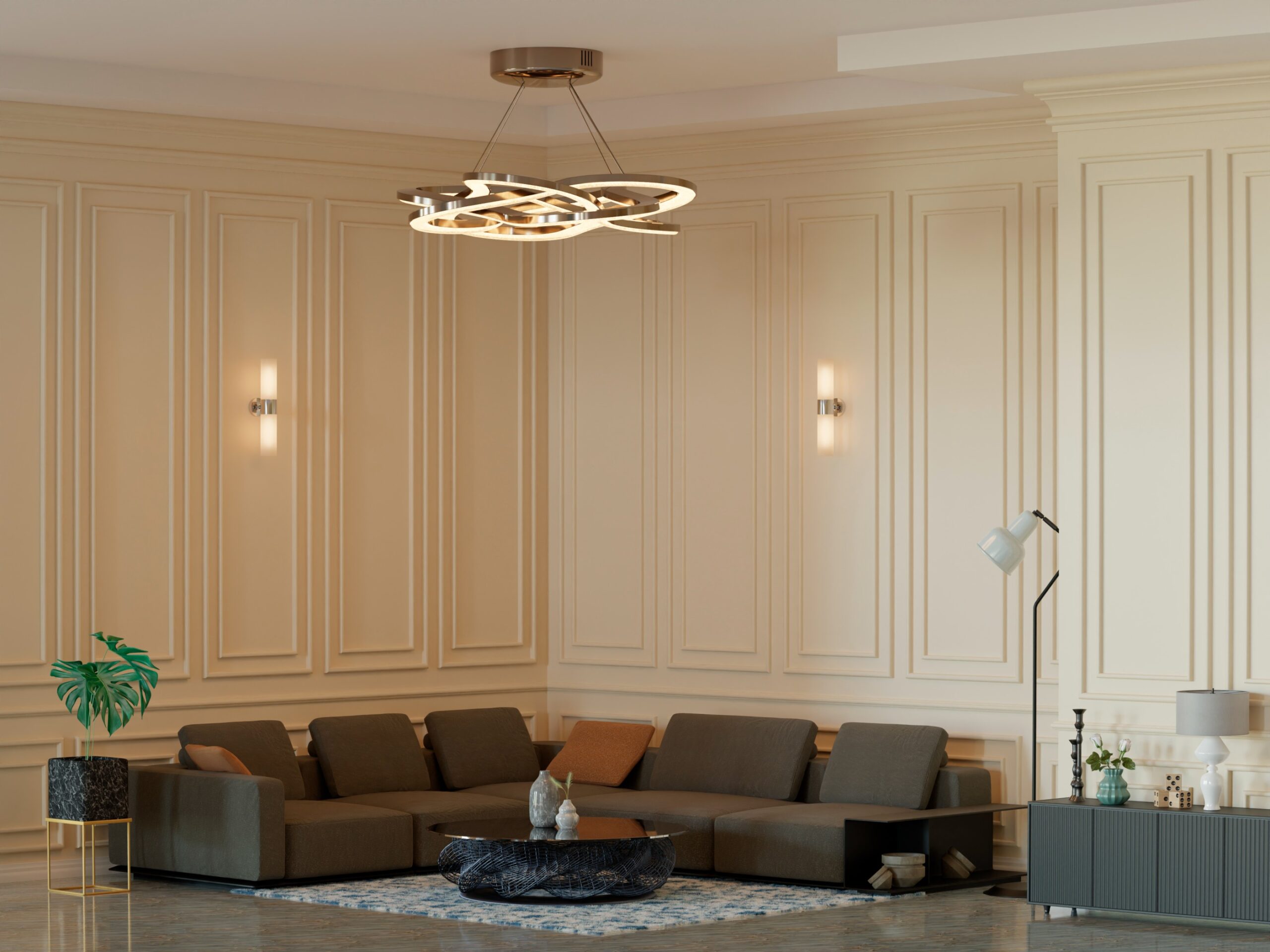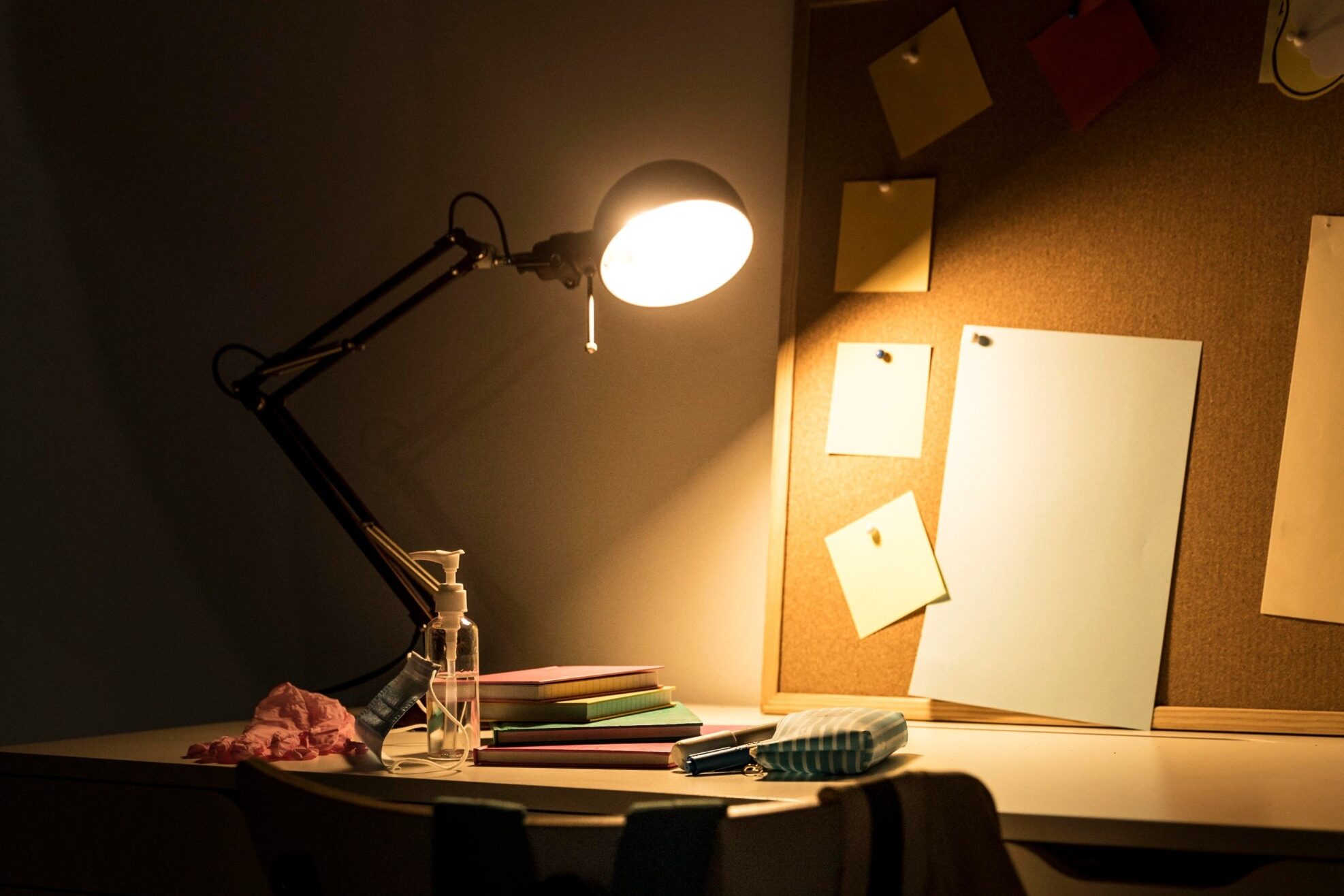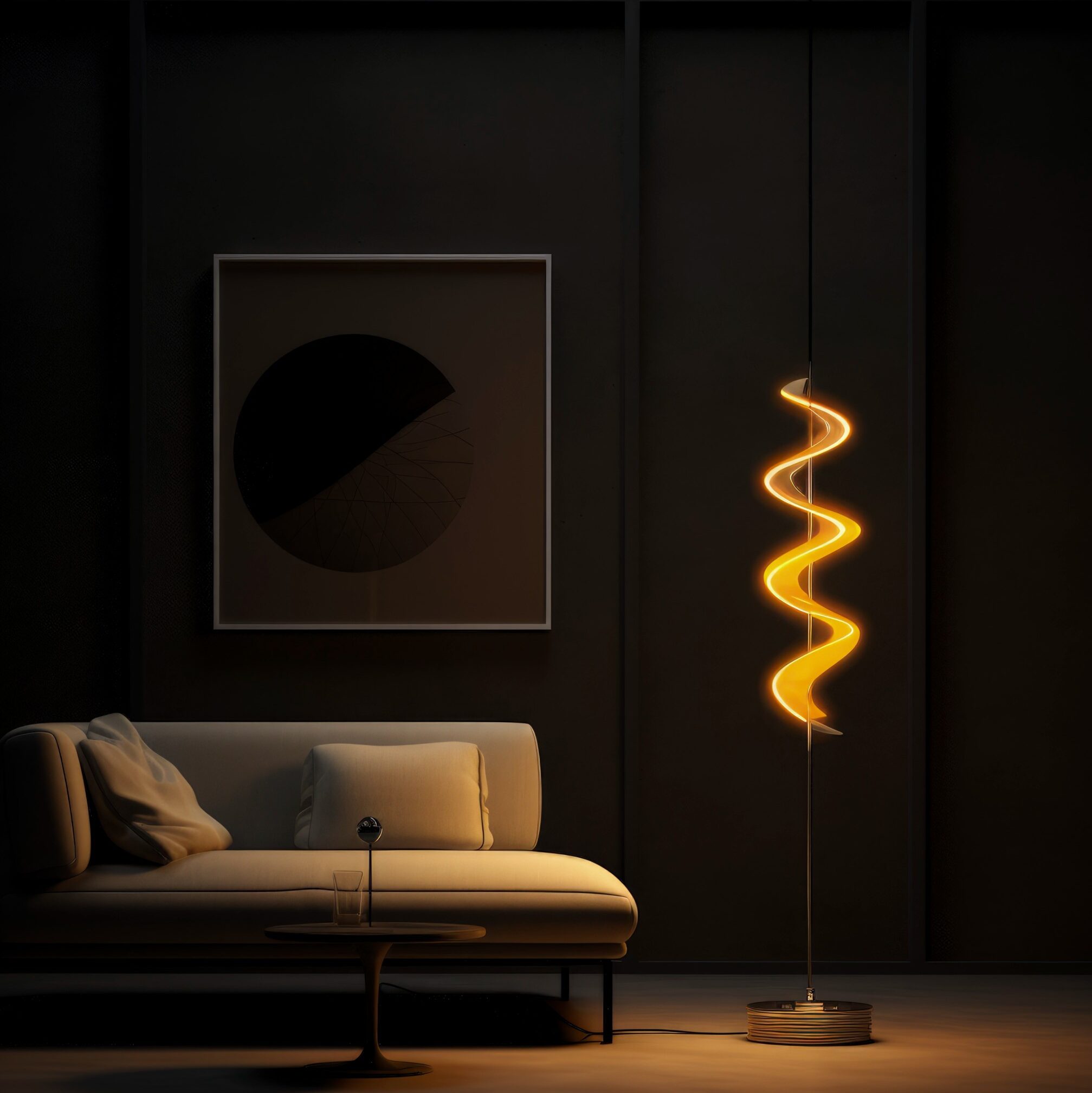Lighting plays a pivotal role in transforming a home from merely a place to live into a sanctuary of comfort, style, and functionality. It not only illuminates spaces but also sets the mood, enhances the ambiance, and highlights key features of your home. Whether you’re redesigning your home or simply looking to refresh your current lighting setup, understanding Lighting Design tips for home is crucial for creating a space that’s both practical and inviting.
In this blog, we’ll explore essential lighting design tips to help you brighten up your home. From choosing the right fixtures to layering light effectively, you’ll find valuable insights that can elevate the look and feel of your home.
Table of Contents
- The Power of Lighting
- Understanding Different Types of Lighting
- Ambient Lighting
- Task Lighting
- Accent Lighting
- Lighting Design Tips for Each Room
- Living Room
- Kitchen
- Bedroom
- Bathroom
- Dining Room
- How to Layer Lighting for a Balanced Effect
- Start with Ambient Lighting
- Add Task Lighting
- Finish with Accent Lighting
- Choosing the Right Lighting Fixtures
- Match the Style
- Size Matters
- Energy-Efficiency
- Sustainable Lighting Design Tips
- Use LED Bulbs
- Install Motion Sensors
- Consider Natural Light
- Conclusion
1. The Power of Lighting
Lighting can either make or break a room’s design. It has the ability to highlight architectural features, create a cozy atmosphere, or energize a space with brightness. The right lighting design not only enhances the overall aesthetics of a room but also improves its functionality, making spaces more comfortable and usable. Understanding Lighting Design tips for home can help you make the most of every room’s potential.
Think of lighting as the finishing touch in your interior design. It influences how we feel and interact with a space, whether it’s the soft glow of a lamp for a relaxing evening or bright lights in the kitchen for cooking. That’s why understanding Lighting Design tips for home is essential to getting the most out of your home’s interior.
2. Understanding Different Types of Lighting
Before diving into specific design tips, it’s essential to understand the different types of lighting that can be incorporated into your home. Lighting plays a crucial role in setting the tone, mood, and functionality of each room. Each type of light serves a distinct purpose and can be used in various combinations to create the perfect ambiance. By layering different lighting types, you can enhance both the aesthetics and practicality of your living spaces.
Ambient Lighting
Ambient lighting is the primary source of light in a room. It provides general illumination and ensures that the space is evenly lit, preventing dark corners and creating a comfortable environment. This foundational layer of lighting is essential for performing everyday activities such as walking, cleaning, and socializing. Common sources of ambient light include ceiling-mounted fixtures, chandeliers, recessed lighting, and track lights. In open-concept spaces, ambient lighting helps define different zones and maintains a cohesive flow throughout the home.

- Tip: Choose dimmable options to adjust the brightness based on your needs and the time of day. This flexibility allows you to create a brighter setting for activities and a softer glow for relaxation in the evenings.
Task Lighting
Task lighting is focused lighting that’s intended to illuminate a specific area where tasks such as reading, cooking, or working take place. Unlike ambient lighting, which covers a broad area, task lighting targets precise spots, enhancing visibility and reducing eye strain. This type of lighting is especially important in areas that require concentration and precision, such as kitchen counters, home offices, and vanity mirrors. Examples include under-cabinet lights in the kitchen, desk lamps in the office, and reading lights beside the bed.

- Tip: Position task lighting directly above or near workspaces for optimal illumination. Ensure the light is bright enough without creating glare or harsh shadows, which can be distracting and uncomfortable.
Accent Lighting
Accent lighting is used to highlight specific features in a room, such as artwork, architectural elements, or decorative objects. It adds drama and depth to a space by creating focal points and drawing attention to special details. Accent lighting is an excellent tool for showcasing your personal style and adding a layer of sophistication to your interior design. Examples of accent lighting include track lighting, spotlights, and picture lights. In outdoor settings, accent lights can also be used to emphasize landscaping features or architectural details.

- Tip: Use accent lighting to create visual interest and enhance the décor of your home. Combining it with ambient and task lighting can add richness and dimension to your space, making it more inviting and visually appealing.
3. Lighting Design Tips for Each Room
Now that we understand the different types of lighting ambient, task, and accent it’s time to explore how to thoughtfully apply them in each room of your home. Lighting has the power to transform your space: it enhances function, sets the mood, and ties your design together. By layering light sources and considering how each room is used, you can create a well-lit, balanced, and beautiful home. Incorporating Lighting Design tips for home ensures each space is both stylish and functional.
Living Room
The living room is the heart of the home a multifunctional space for relaxing, watching TV, entertaining guests, or reading. Because of its versatility, the lighting here must be both practical and atmospheric.
- Layer the Lighting: Start with an overhead ambient source like a central chandelier, flush-mount, or semi-flush fixture to ensure general illumination. Then, introduce task lighting such as floor lamps beside a reading chair, swing-arm wall lamps, or table lamps on side tables for focused activities. Finally, incorporate accent lighting to bring depth and dimension use wall sconces, LED cove lighting, or directional spotlights to highlight decorative elements, artwork, or architectural features like crown molding, columns, or built-ins.
- Use Floor and Table Lamps: Floor lamps can act as statement pieces, especially in minimalist, industrial, or contemporary interiors. Choose designs with unique silhouettes or mixed materials to complement your décor. Opt for lampshades that diffuse light softly to create a cozy, ambient glow. Table lamps, placed on sideboards or end tables, offer localized pools of warm light ideal for conversation, reading, or enhancing the room’s inviting atmosphere.
- Highlight Artwork or Features: Use picture lights to cast an elegant, focused glow on paintings, photographs, or gallery walls. Adjustable recessed spotlights can be directed toward sculptures, textured surfaces like stone or brick, or accent walls to create contrast and visual interest. LED strips are perfect for illuminating shelves, under mantels, or along architectural niches, giving the space a curated and sophisticated feel.
Kitchen
The kitchen is a workspace, so it requires a good amount of task lighting to ensure functionality. However, you can also incorporate accent lighting to enhance the space’s aesthetic appeal.
- Task Lighting Over Work Areas: Install pendant lights over kitchen islands to provide focused illumination for food prep, cooking, or casual dining. Choose fixtures with adjustable heights and shades that direct light downward for maximum effectiveness. Under-cabinet lighting is essential for brightening countertops and eliminating shadows created by overhead cabinets. Opt for LED strips or puck lights for a sleek, modern look and energy efficiency.
- Bright, Even Ambient Lighting: Use recessed lighting strategically spaced across the ceiling to provide consistent general lighting throughout the kitchen. Combine with flush-mount or semi-flush ceiling fixtures in central areas to avoid dark spots and ensure the entire room is well lit. Consider using daylight LED bulbs to enhance visibility and create a fresh, clean atmosphere conducive to productivity.
- Accent Lighting for the Dining Area: If your kitchen includes a breakfast nook or dining area, hang a statement chandelier or a set of pendant lights directly above the table to define the space and add a decorative focal point. Choose lighting that complements your kitchen’s style such as a linear suspension light for a modern kitchen or a wrought-iron chandelier for a rustic or farmhouse feel. Dimmable features can help transition the space from bright daytime meals to cozy evening dinners.
Bedroom
In the bedroom, lighting should create a calm, relaxing atmosphere while also being functional. Here are some ideas:
- Layer the Lighting: Use ambient lighting such as a central ceiling fixture, chandelier, or flush-mount light to provide overall illumination. Complement this with task lighting like bedside table lamps or pendant lights hung above nightstands for activities such as reading or journaling. Add accent lighting, including wall sconces, LED strip lights behind the headboard, or under-bed lighting, to introduce soft, indirect glows that enhance relaxation and create depth in the room’s design.
- Dimmable Lights: Install dimmable fixtures or bulbs to customize light levels throughout the day. Brighten the space in the morning for energizing routines and dim the lights in the evening to encourage rest and unwind. Smart lighting options allow for automatic adjustment based on time or mood, offering both convenience and comfort.
- Task Lighting for Reading: Place table lamps with adjustable shades or articulated wall-mounted sconces on either side of the bed for targeted illumination during reading sessions. Choose warm white bulbs to reduce eye strain and create a cozy ambiance. Make sure the lights are easily accessible from the bed for maximum convenience.
Bathroom
Bathroom lighting needs to be both practical and aesthetic, helping with daily tasks like grooming while creating a spa-like atmosphere.
- Bright Task Lighting Near Mirrors: Install wall-mounted sconces on either side of the mirror or an overhead vanity light to ensure even, shadow-free illumination for grooming tasks like shaving, applying makeup, or skincare routines. Choose fixtures with frosted glass or integrated LED panels for a clean, bright light that is gentle on the eyes. Position lights at eye level whenever possible to reduce shadows and enhance visibility.
- Ambient Lighting for Relaxation: Use ceiling-mounted fixtures or recessed lights with dimmable features to create soft, general lighting throughout the bathroom. For areas like the bathtub or shower, consider moisture-rated fixtures that emit a gentle, diffused glow to promote a calm and spa-like environment. Warm color temperatures work best to encourage relaxation and comfort.
- Accent Lighting for Style: Incorporate LED strip lights under floating vanities, inside recessed shelving, or along architectural details like shower niches or tray ceilings. These subtle light sources add a modern aesthetic and enhance the bathroom’s design without overwhelming the space. RGB options can also be used to introduce customizable mood lighting for a personalized experience.
Dining Room
The dining room is where you gather to share meals, so lighting plays a significant role in setting the tone for a meal.
- Pendant Lights or Chandeliers: Hang a statement chandelier or a set of pendant lights centered above the dining table to serve as the room’s focal point. Choose a fixture that complements the room’s style such as a crystal chandelier for a traditional setting, or a minimalist linear pendant for a modern look. Ensure the light hangs 30 to 36 inches above the table surface to provide ample illumination without obstructing views or conversation. Multi-bulb fixtures can offer both style and functionality, evenly distributing light across the entire table.
- Dimmable Lights: Install dimmer switches to control the brightness level based on the occasion. Brighten the space for daytime dining or family gatherings, and dim the lights to create a warm, intimate ambiance for evening meals or special occasions. This flexibility allows you to easily shift the mood from casual to elegant, enhancing the overall dining experience. For added convenience, consider smart dimming systems that can be controlled via app or voice command.
4. How to Layer Lighting for a Balanced Effect
One of the key principles of lighting design is layering. Layering different types of lighting ambient, task, and accent helps create a dynamic and functional space. Here’s how to do it effectively:
- Start with Ambient Lighting: The base layer of lighting, ambient lighting provides general illumination that ensures the entire room is evenly lit. It sets the overall tone and makes the space feel open, comfortable, and inviting. Common sources include ceiling-mounted fixtures, recessed downlights, or large-scale pendants. Choose fixtures that complement your décor and distribute light uniformly. In larger rooms, consider combining multiple ambient sources to avoid dark zones and maintain visual balance.
- Add Task Lighting: After establishing ambient lighting, introduce task lighting in areas that require brighter, more focused illumination. This includes desk lamps in workspaces, under-cabinet lights in kitchens, vanity lights in bathrooms, and reading lamps in bedrooms or living areas. Task lighting reduces eye strain and enhances productivity by targeting specific zones. Select adjustable fixtures or lights with directional capabilities to concentrate the beam exactly where it’s needed.
- Finish with Accent Lighting: Complete your lighting design with accent lighting to add visual interest and highlight unique features in the room. Use LED strips along shelves, picture lights above artwork, or spotlights to draw attention to architectural details like textured walls or alcoves. Accent lighting adds layers of depth and a sense of drama, transforming a flat space into a dynamic, well-composed environment. Consider using dimmers or colored lighting for additional mood-setting flexibility.
5. Choosing the Right Lighting Fixtures
The lighting fixtures you choose can drastically change the look of your home. Here are some tips for selecting the right fixtures:
- Match the Style: Select lighting fixtures that harmonize with the overall design aesthetic of your home. For modern or industrial interiors, consider fixtures with clean lines, metal finishes, and minimalist designs. In contrast, traditional or classic spaces benefit from ornate chandeliers, vintage-inspired sconces, or fixtures with intricate detailing. Matching your fixtures to the room’s style creates a cohesive and polished look.
- Size Matters: Pay close attention to the scale and proportion of your lighting fixtures relative to the room size and furniture. A large, dramatic chandelier can serve as a stunning centerpiece in a spacious dining room or foyer but may feel overpowering in a small bedroom or bathroom. Measure your space carefully and choose fixtures that balance well with the dimensions of the room to maintain visual harmony.
- Energy-Efficiency: Prioritize energy-efficient lighting by opting for LED bulbs and fixtures designed to reduce power consumption. LEDs last significantly longer than traditional incandescent bulbs and emit less heat, making them safer and more cost-effective over time. Many modern LED options also offer adjustable color temperatures and dimming capabilities, allowing you to customize ambiance while saving energy.
6. Sustainable Lighting Design Tips
Sustainable lighting is all about choosing energy-efficient solutions that reduce your environmental impact while saving on electricity bills. Here are some sustainable lighting tips:
- Use LED Bulbs: LED bulbs are the most energy-efficient lighting option available today. They consume significantly less electricity than traditional incandescent or halogen bulbs and can last up to 25 times longer. LEDs also produce less heat, making them safer and ideal for use in a variety of fixtures. Available in a range of color temperatures and styles, LED bulbs provide flexibility for creating different moods and lighting effects.
- Install Motion Sensors: Motion sensor lighting automatically turns lights on when someone enters a room and off after a period of inactivity. This helps reduce wasted energy by ensuring lights aren’t left on unnecessarily, especially in less frequently used spaces like hallways, closets, or bathrooms. Motion sensors are easy to install and can be integrated with smart home systems for added convenience.
- Consider Natural Light: Harnessing natural light not only reduces energy consumption but also enhances the mood and feel of your home. Use light-colored walls, reflective surfaces like mirrors, and sheer window treatments to amplify daylight. Large windows and glass doors can flood rooms with sunlight, while skylights or light tubes are excellent options to bring daylight into darker areas such as basements, hallways, or interior rooms. Natural light also improves well-being and creates a connection with the outdoors.
7. Conclusion
Lighting design is essential to creating a home that’s both functional and beautiful. By understanding the different types of lighting, layering light effectively, and selecting the right fixtures, you can enhance the aesthetic appeal of your home while also making it more practical. Whether you’re looking to brighten up a cozy living room or create a spa-like atmosphere in your bathroom, the right lighting can make all the difference. That’s why incorporating Lighting Design tips for home is key to achieving a well-balanced and inviting space.
Don’t be afraid to experiment with different lighting combinations until you find the perfect balance for your home. Remember, a well-lit home is not only more inviting, but it also contributes to your overall well-being and comfort.




